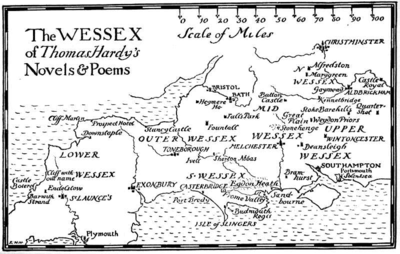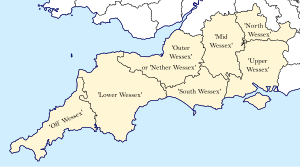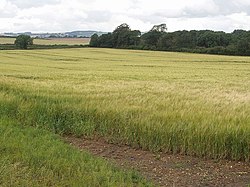Thomas Hardy's Wessex
Thomas Hardy's Wessex is the fictional landscape in which Thomas Hardy set his 'Wessex' novels, but which reflects the actual geography of Dorset, his home county, and some places around it. For the purpose of his novels, the places and the counties of the West Country took on a fictionalised set of names. The vast majority of places lay in 'South Wessex': his fictional version of Dorset.
The name 'Wessex' is taken from that of the ancient Kingdom of the West Saxons, which encompassed the West Country. The places that appear in his novels actually exist, but in many cases he gave the place a fictional name.[1] For example, Hardy's home town of Dorchester is called 'Casterbridge' in his books, notably in The Mayor of Casterbridge.[2][3] In an 1895 preface to the 1874 novel Far From the Madding Crowd he described Wessex as "a merely realistic dream country".[4]
The actual definition of "Hardy's Wessex" varied widely throughout Hardy's career, and was not definitively settled until after he retired from writing novels. When he created the concept of a fictional Wessex, it consisted merely of the small area of Dorset in which Hardy grew up; by the time he wrote Jude the Obscure, the boundaries had extended to include all of Dorset, Wiltshire, Somerset, Devon, Hampshire, much of Berkshire, and some of Oxfordshire, with its most north-easterly point being Oxford (renamed "Christminster" in the novel). Cornwall was also referred to but named "Off Wessex". The nature and significance of ideas of "Wessex" were developed over a long series of novels through a lengthy period of time. The idea of Wessex plays an important artistic role in Hardy's works (particularly his later novels), assisting the presentation of themes of progress, primitivism, sexuality, religion, nature and naturalism; however, this is complicated by the economic role Wessex played in Hardy's career. Considering himself primarily to be a poet, Hardy wrote novels mostly to earn money. Books that could be marketed under the Hardy brand of "Wessex novels" were particularly lucrative, which gave rise to a tendency to sentimentalised, picturesque, populist descriptions of Wessex – which, as a glance through most tourist giftshops in the south-west will reveal, remain popular with consumers today.
Hardy's resurrection of the name "Wessex" is largely responsible for the popular modern use of the term to describe the south-western shires, and many organisations take their name from Hardy to describe their relationship to the area.[5]
Thomas Hardy's Wessex names
Wessex regions and actual English counties
Hardy did not always use the historic boundaries in his writings, but he had particular counties in mind and many of the fictional places of his novels and his poems are thinly fictionalised versions of real towns and villages in Dorset and other counties.
| Region of Wessex | Actual County[6] |
|---|---|
| Lower Wessex | Devon |
| Mid Wessex | Wiltshire |
| North Wessex | Berkshire |
| Outer Wessex or 'Nether Wessex' |
Somerset |
| South Wessex | Dorset |
| Upper Wessex | Hampshire |
Outer Wessex is sometimes referred to as Nether Wessex.
Specific places in Thomas Hardy's Wessex
Key to references for the place-name table
The abbreviations for Thomas Hardy's novels that are used in the table are as follows:
| DR | Desperate Remedies (1871) |
| UtGT | Under the Greenwood Tree (1872) |
| PoBE | A Pair of Blue Eyes (1873) |
| FftMC | Far from the Madding Crowd (1874) |
| HoE | The Hand of Ethelberta (1876) |
| RotN | The Return of the Native (1878) |
| TM | The Trumpet-Major (1880) |
| L | A Laodicean (1881) |
| ToaT | Two on a Tower (1882) |
| MoC | The Mayor of Casterbridge (1886) |
| W | The Woodlanders (1887) |
| WT | Wessex Tales (1888) |
| TotD | Tess of the d'Urbervilles (1891) |
| JtO | Jude the Obscure (1895) |
| WB | The Well-Beloved (1897) |
| WP | Wessex Poems and Other Verses (1898) |
Table of Wessex place-names, their actual places, and their appearance in Hardy's novels
| Wessex Name | Part of Wessex | Actual Name | Appearance in Hardy's works[6][7] |
|---|---|---|---|
| Abbot's-Cernel | South Wessex | Cerne Abbas | Where Mrs Dollery was driving to in the beginning of the novel. (W) |
| Abbotsea | South Wessex | Abbotsbury | |
| Aldbrickham | North Wessex | Reading | Where Jude and Sue lived together after Sue left Phillotson. It is also where Arabella used to work as a barmaid before she met Jude. (JtO) |
| Alfredston | North Wessex | Wantage | Jude Fawley becomes a mason's apprentice there. It is also where he works following his marriage to Arabella Donn. (JtO) |
| Anglebury | South Wessex | Wareham | Where Thomasin and Wildeve's marriage did not take place due to an invalid licence (RotN) Where Ethelberta lodged in the beginning of the novel. (HoE) |
| Bramshurst | Upper Wessex | Lyndhurst | Tess and Angel fled to an unoccupied manor house in Bramshurst near the end of the novel. (TotD) |
| Budmouth | South Wessex | Weymouth | Where Frank Troy goes to gamble on horse races. (FftMC) Eustacia Vye's hometown (RotN) The working place of Owen. (DR) On the way home from Budmouth, Dick and Fancy confessed to each other. (UtGT) One of the cities where Farfrae did his business. (MoC) The major neighbouring city of Overcombe, the principal location of the novel. It is sometimes called Budmouth-Regis in Hardy's novels, but that is more precisely Melcombe Regis, where George III popularised the watering place; Weymouth is the other side of the river.(TM) |
| Casterbridge | South Wessex | Dorchester | The principal location of The Mayor of Casterbridge. (MoC) Where Fanny Robin dies at the poorhouse, and whose Corn Exchange is frequently visited by Bathsheba and Boldwood. (FftMC) Where Rhoda and Farmer Lodge's son is hanged. The Withered Arm. (WT)[8] When Tess's horse died while delivering goods from her home town to Casterbridge. (TotD) |
| Chalk Newton | South Wessex | Maiden Newton | Site of Flintcomb-Ash farm, where Tess worked after Angel left her. (TotD) |
| Chaseborough | South Wessex | Cranborne | Tess passed through Chaseborough on the way from home to Trantridge. (TotD) |
| Christminster | North Wessex | Oxford | Where Jude Fawley goes to become a scholar, and is advised to give up his career choice. Sue Bridehead works in a shop which produces religious artefacts there, meets her cousin, and is thrown from her lodgings. (JtO) Cytherea and Owen's hometown. Although Christminster is technically not within the borders of Hardy's Wessex, as it is located to the north of the River Thames, he describes it in Jude the Obscure as "within hail of the Wessex border, and almost with the tip of one small toe within it". (DR) |
| Cliff Martin | Outer Wessex | Combe Martin | Combe Martin is actually in Devon, indicating that Hardy's boundaries are not necessarily linked to current county boundaries |
| Cresscombe | North Wessex | Letcombe Bassett | Arabella's hometown. (JtO) |
| Deansleigh | South Wessex | Romsey | Sir Ashley Mottisfont and his Lady Philipa reside at Deansleigh Park (probably a reference to Broadlands).[9] |
| Downstaple | Lower Wessex | Barnstaple | |
| Durnover | South Wessex | Fordington | |
| Endelstow | Off Wessex | St Juliot | The home of Elfride Swancourt and her Rector father (PoBE). In real life this was where Thomas met Emma whom he later married. |
| Emminster | South Wessex | Beaminster[8] | The home of Angel Clare, and the site of Clare's father's vicarage. (TotD) |
| Evershead | South Wessex | Evershot | Where Tess met Alec for the first time after they parted, when Alec was preaching. (TotD) |
| Exonbury | Lower Wessex | Exeter | Where Grace went to after she found out Fitzpier's affair. (W) |
| Falls Park | Outer Wessex | Mells Park | |
| Fountall | Outer Wessex | Wells | |
| Gaymead | North Wessex | Theale | (JtO and WT) |
| Havenpool | South Wessex | Poole | Newson landed here on his return from Newfoundland. (MoC) |
| Isle of Slingers | South Wessex | Isle of Portland | The principal location of the Well-Beloved. (WB) |
| Ivell | Outer Wessex | Yeovil | |
| Kennetbridge | North Wessex | Newbury | "A thriving town not more than a dozen miles south of Marygreen" (JtO)[10] between Melchester and Christminster.[11] The main road (A338) from Oxford to Salisbury runs past Fawley and through Hungerford, which may be Kennetbridge instead of Newbury, which is to the south-east of Fawley. |
| Kingsbere | South Wessex | Bere Regis | Here is situated the Church of the d'Urbervilles. After Tess' Father's death, the Durbeyfield family take refuge outside the chapel. (TotD) |
| Knollsea | South Wessex | Swanage | Where Lord Mountclere lived. (HoE) |
| Lulwind Cove | South Wessex | Lulworth Cove | Where Sergeant Troy is thought to have drowned. (FftMC) |
| Lumsdon | North Wessex | Cumnor | It is there that Jude Fawley meets up with his old teacher Mr. Phillotson again. It is where Sue Bridehead starts to work as a teacher and promises herself in marriage to Mr. Phillotson. (JtO) |
| Marlott | South Wessex | Marnhull | Tess Durbeyfield is born and brought up there. After becoming pregnant by Alec D'Urberville she returns to the village and gives birth to a baby boy, who dies in infancy. (TotD) |
| Marygreen | North Wessex | Fawley | Drusilla Fawley runs a bakery there. It is the place where Sue Bridehead spent her childhood. Jude Fawley is brought there following the death of his father, and it is where he matures into a man. (JtO) |
| Melchester | Mid Wessex | Salisbury | This is the place where Jude goes to prepare himself for the ministry, and where Sue Bridehead is studying to become a teacher. The latter runs away from her school there, and later marries Mr. Phillotson in the town. (JtO) Where Troy's military camp deployed. (FftMC) Where Julian moved to after Ethelberta refuse his love. (HE) Lord Helmsdale was the bishop of Melchester. (ToaT) |
| Mellstock | South Wessex | Stinsford and Higher & Lower Bockhampton | Thomas Hardy's birthplace. Hardy's heart is also buried here, next to his first wife, Emma. Jude Fawley's father died there. (JtO) Nearly all of Under the Greenwood Tree is set in Mellstock. (UtGT) |
| Middleton | South Wessex | Milton Abbas | Where Charmond lived. (W) |
| Middleton Abbey | South Wessex | Milton Abbey | Where Charmond lived. (W) |
| Narrowbourne | Outer Wessex | West Coker | Where the main character is a priest in A Tragedy of Two Ambitions a short story part of Life's Little Ironies. |
| Overcombe | South Wessex | Sutton Poyntz | The principal location of The Trumpet-Major.(TM) One of the places from where the vans of carriers in and out of Casterbridge hailed. (MoC)[12] |
| Port Bredy | South Wessex | Bridport[8] | Where Lucetta and Farfrae secretly married. (MoC) |
| Po'sham | South Wessex | Portesham | The home of Captain Thomas Hardy, one of Lord Nelson's commanders at the Battle of Trafalgar, who lived at Portesham House. (TM) |
| Quartershot | Upper Wessex | Aldershot | An important military station near Stoke-Barehills. (JtO) |
| Sandbourne | Upper Wessex | Bournemouth[8] | Where Tess Durbeyfield lives with Alec D'Urberville as his mistress, and where she murders him upon the return of her husband, Angel Clare. (TotD). It is also where Sue Bridehead's freethinking friend was buried, and where she was the only mourner at his funeral. (JtO) The principal location of The Hand of Ethelberta. (HoE) Where Tess and Alec lived after they got married. (TotD) |
| Shaston | South Wessex | Shaftesbury | Jack Durbeyfield visits the doctor in Shaston and learns that he has a bad heart. (TotD) Mr. Phillotson moves there to run a school. Jude Fawley travels there to see Sue Bridehead, who, married to Mr. Phillotson, is working in the town, and they flee the place together. (JtO) |
| Sherton Abbas | South Wessex | Sherborne[8] | The major neighboring city of the Hintocks, where The Woodlanders took place. (W) |
| Slingers | South Wessex | Isle of Portland | The principal location of The Well-Beloved. (WB) |
| Solentsea | Upper Wessex | Southsea | The setting of the short story "An Imaginative Woman." |
| Stancy Castle | Outer Wessex | Dunster Castle | The principal location of A Laodicean. (L) |
| Stoke Barehills | Upper Wessex | Basingstoke | Where Great Wessex Agricultural Show was held. (JtO) |
| Street of Wells | South Wessex | Fortuneswell | The main street on Isle of Slingers, where The Well-Beloved mostly took place. (WB) |
| Toneborough | Outer Wessex | Taunton | |
| Trantridge | South Wessex | Pentridge | Site of the D'Urberville estate. (TotD) |
| Weatherbury | South Wessex | Puddletown[8] | Farms of Bathsheba and Boldwood, main setting for Far From the Madding Crowd (FftMC) |
| Weatherbury Farm | South Wessex | Waterston Manor | Bathsheba's farm, in Far From the Madding Crowd (FftMC) |
| Wellbridge | South Wessex | Wool | Where Tess and Angel spend their wedding night and Tess confesses. (TotD) |
| Weydon-Priors | Upper Wessex | Weyhill | Where Michael Henchard sells his wife while he is drunk. (MoC) |
| Wintoncester | South Wessex | Winchester | Tess Durbeyfield is imprisoned and executed in this former capital of Wessex. (TotD) |
In art and books
Artists such as Walter Tyndale, Edmund Hort New, Charles George Harper and others, have painted or drawn the landscapes, places and buildings described in Hardy's novels. Their work was used to illustrate books exploring the real-life countryside on which the fictional county of Wessex was based:
- B. C. A. Windle & Edmund Hort New (ill.). The Wessex of Thomas Hardy (London, New York, J. Lane, 1902).
- Charles G. Harper. The Hardy country; literary landmarks of the Wessex novels (London, A. & C. Black, 1904).
- Clive Holland. Wessex (A & C Black, 1906).
- Sidney Heath.The Heart of Wessex (Blackie & Son, 1910?).
- Charles G. Harper. Wessex ("Beautiful Britain", London: A. & C. Black, 1911).
- R. Thurston Hopkins & E. Harries (ill.). Thomas Hardy's Dorset (New York: D. Appleton and co. 1922).
- Hermann Lea. Thomas Hardy's Wessex (Macmillan and co. 1911).
- Ralph Pite, Hardy's geography: Wessex and the regional novel. Palgrave, 2002.
- Andrew D. Radford, Mapping the Wessex novel: landscape, history and the parochial in British literature, 1870–1940. (London; New York: Continuum International Pub., 2010.
- Walter Tyndale. Hardy country water-colours (A & C Black, 19??).
- Barry J Cade. Thomas Hardy's Locations (Casterbridge Publishing Limited 2015) A full colour tourist guide to the places Hardy had in mind when he wrote "The Mayor of Casterbridge" and "Far from the Madding Crowd."
Outside links
- Hardy's Wessex: The Hardy Society
- Where is Thomas Hardy's Wessex?: National Trust
References
- ↑ "Map of Thomas Hardy's Wessex". British Library. http://www.bl.uk/collection-items/map-of-thomas-hardys-wessex. Retrieved 25 November 2015.
- ↑ Birchall, Eugene. "Wessex Place Names". Wessex Photos. http://www.eugenebirchall.co.uk/page80.html. Retrieved 25 November 2015.
- ↑ "An Introduction To Hardy's Wessex". South Coast Central. http://south-coast-central.co.uk/hardy.htm. Retrieved 25 November 2015.
- ↑ "Exploring Thomas Hardy's West Dorset". Visit Dorset. http://www.visit-dorset.com/dbimgs/Hardy%20Country%20leaflet%2005%2006%20-%20web.pdf. Retrieved 25 November 2015.
- ↑ "Thomas Hardy's Wessex?". University of St Andrews. https://www.st-andrews.ac.uk/~bp10/wessex/introduction/. Retrieved 25 November 2015.
- ↑ 6.0 6.1 "Wessex Novel Placenames". Dorsetshire.com. http://www.dorsetshire.com/hardy/hardy_placenames.html. Retrieved 25 November 2015.
- ↑ "Wessex place-names". Thomas Hardy's Wessex. https://sites.google.com/site/thomashardyswessex/wessex-place-names. Retrieved 25 November 2015.
- ↑ 8.0 8.1 8.2 8.3 8.4 8.5 "Thomas Hardy's Dorset inspirations". BBC. https://www.bbc.co.uk/news/uk-england-dorset-32393785. Retrieved 25 November 2015.
- ↑ Ray, Martin (2016). Thomas Hardy: A Textual Study of the Short Stories. London: Routledge. pp. 105. ISBN 1351879375. https://books.google.co.uk/books?id=T5qoDQAAQBAJ&pg=PT166&lpg=PT166&dq=thomas+hardy+romsey+deansleigh&source=bl&ots=DUOAnSnLcz&sig=ACfU3U0zaeGjnR18ZCa1xAObRDbXjRlZPg&hl=en&sa=X&ved=2ahUKEwi-8JXOsrnkAhUSuRoKHf55CPkQ6AEwDHoECAcQAQ#v=onepage&q=thomas%20hardy%20romsey%20deansleigh&f=false.
- ↑ Paragraph 4, Chapter VII, Part Fifth, Thomas Hardy, Jude the Obscure at https://www.gutenberg.org/files/153/153-h/153-h.htm#5-7
- ↑ Paragraph 6, Chapter X, Part Third, Thomas Hardy, Jude the Obscure at https://www.gutenberg.org/files/153/153-h/153-h.htm#5-7
- ↑ Chapter IX, Thomas Hardy, The Mayor of Casterbridge at http://www.gutenberg.org/files/143/143-h/143-h.htm


